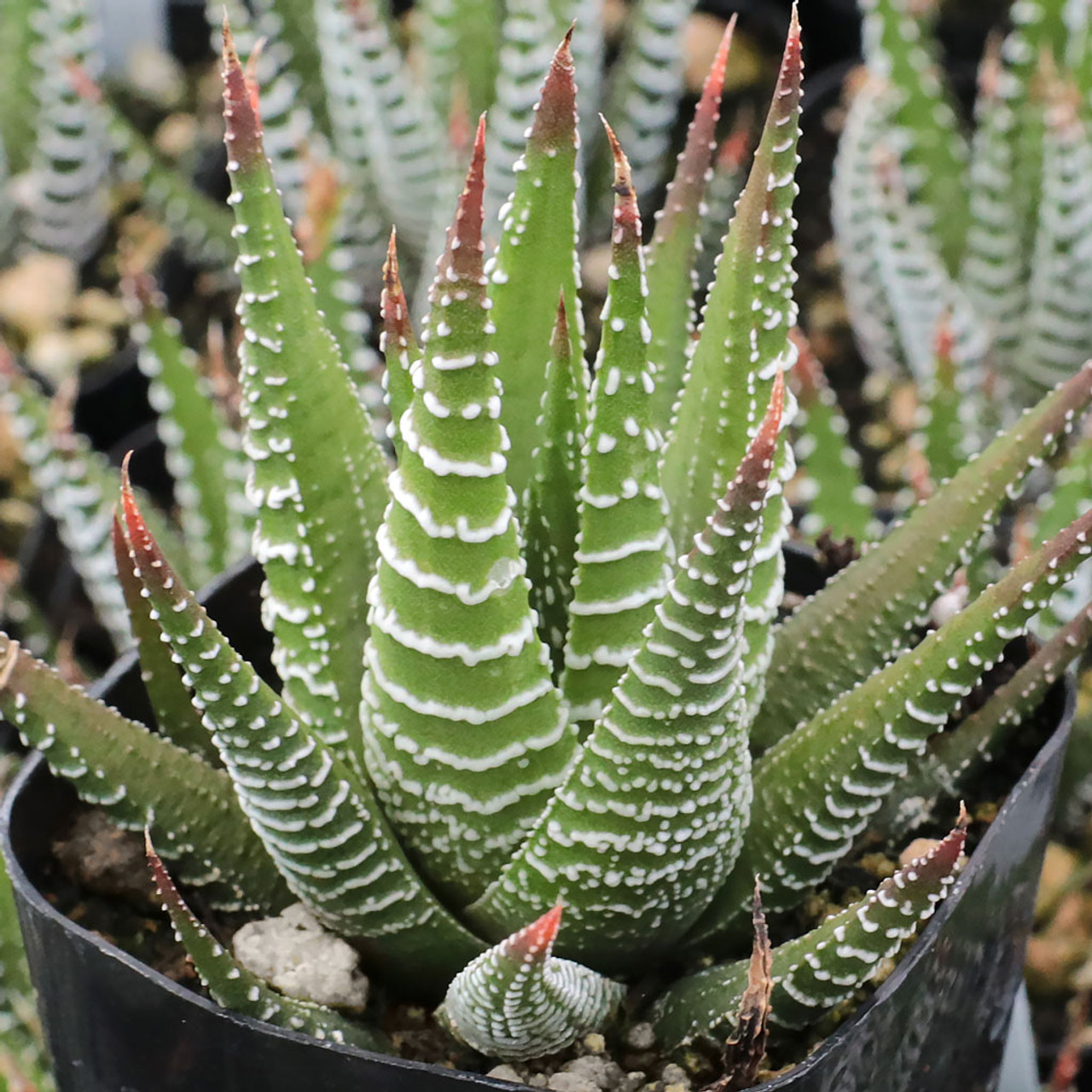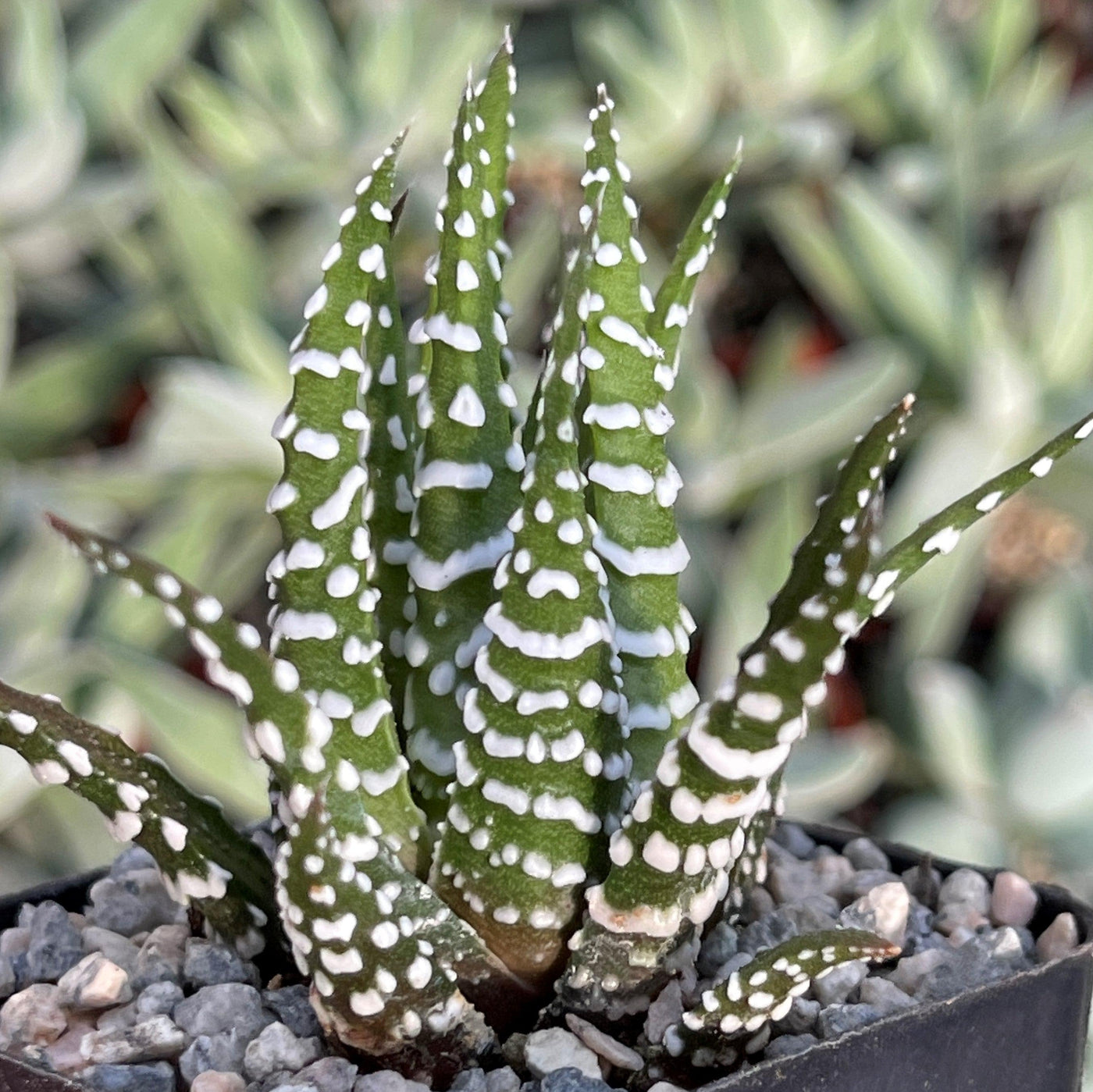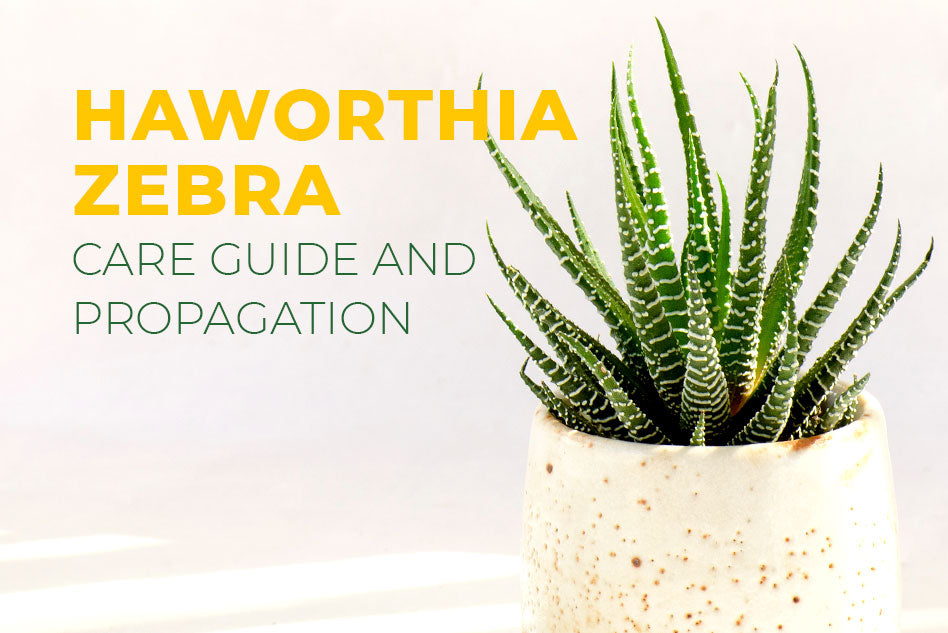This succulent is an ideal addition to your indoor succulent garden. Its leaves are thick, dark green with white horizontal stripes on the outside, and the surfaces are smooth to the touch.
Table of Contents
Care and Propagation Information
Haworthiopsis fasciata “Zebra Plant” is an ideal succulent for those unfamiliar with growing plants indoors. It is relatively easy to take care of and thrives in household conditions. It can be propagated with ease, making it an ideal choice for creating decorative arrangements or for giving as gifts.
Watering
Haworthiopsis fasciata “Zebra Plant” requires typical care for a succulent; it is advisable to use the “soak and dry” method of watering, allowing the soil to be completely dry between waterings.
Be sure to get your hands on our complimentary watering cheat sheet so you can find out how to identify when your succulents are over-watered and how to bring them back to life.
Where to Plant
Haworthiopsis fasciata is not tolerant of cold temperatures, so it should be planted in a pot that can be brought indoors if you live in an area with temperatures that drop below 30° F (-1.1° C).
Plant this in a spot in your garden that gets direct sunlight for 4-6 hours in the morning.
If exposed to greater amounts of sunlight, the plant will turn a darker shade of red, indicating it is under stress. Too much sun will cause it to turn white and wither.
Put the plant in a sunny spot in your home, such as a window that receives direct sunlight.
Flowering Information
When cultivated outside, Haworthiopsis fasciata blooms in autumn. It produces tiny white or pink blossoms on long, slender stalks.
How to Propagate Haworthiopsis fasciata
Haworthiopsis fasciata “Zebra Plant” can be easily spread by its offshoots.
Offsets
The Zebra Plant will create small plantlets around its base. Carefully take these off and let them dry for 24 to 48 hours before planting them in soil with good drainage.
Commonly Mistaken For
Haworthiopsis attenuata is easily distinguishable from other species due to its unique characteristics. Although the distinctions may be subtle, one can easily identify it by looking at its narrow, pointed leaves.
The leaves of Haworthiopsis fasciata “Zebra Plant” are generally smoother than those of Haworthiopsis attenuate, and they are also thicker.
The Zebra Plant is frequently mistaken for Aloe, which has similar foliage that can range from dark to bright green and is characterized by its chubby, pointed leaves.
Previously Known As
Care and Propagation Information
General Care for Haworthiopsis fasciata
Haworthiopsis fasciata “Zebra Plant” is an ideal succulent for those unfamiliar with growing plants indoors. It is relatively easy to take care of and thrives in household conditions. It can be propagated with ease, making it an ideal choice for creating decorative arrangements or for giving as gifts.
Watering
Haworthiopsis fasciata “Zebra Plant” requires typical care for a succulent; it is advisable to use the “soak and dry” method of watering, allowing the soil to be completely dry between waterings.
Be sure to get your hands on our complimentary watering cheat sheet so you can find out how to identify when your succulents are over-watered and how to bring them back to life.
Where to Plant
Haworthiopsis fasciata is not tolerant of cold temperatures, so it should be planted in a pot that can be brought indoors if you live in an area with temperatures that drop below 30° F (-1.1° C).
Plant this in a spot in your garden that gets direct sunlight for 4-6 hours in the morning.
If exposed to greater amounts of sunlight, the plant will turn a darker shade of red, indicating it is under stress. Too much sun will cause it to turn white and wither.
Put the plant in a sunny spot in your home, such as a window that receives direct sunlight.
Flowering Information
When cultivated outside, Haworthiopsis fasciata blooms in autumn. It produces tiny white or pink blossoms on long, slender stalks.
How to Propagate Haworthiopsis fasciata
Haworthiopsis fasciata “Zebra Plant” can be easily spread by its offshoots.
Offsets
The Zebra Plant will create small plantlets around its base. Carefully take these off and let them dry for 24 to 48 hours before planting them in soil with good drainage.
Commonly Mistaken For
Haworthiopsis attenuata is easily distinguishable from other species due to its unique characteristics. Although the distinctions may be subtle, one can easily identify it by looking at its narrow, pointed leaves.
The leaves of Haworthiopsis fasciata “Zebra Plant” are generally smoother than those of Haworthiopsis attenuate, and they are also thicker.
The Zebra Plant is frequently mistaken for Aloe, which has similar foliage that can range from dark to bright green and is characterized by its chubby, pointed leaves.
Previously Known As
Haworthia fasciata, sometimes known as the “Zebra Plant,” is a type of succulent.
FAQ
How often should I water my zebra haworthia?
Water your plant every 2-3 weeks, allowing the soil to dry out between waterings. The amount of water you will need to give your plant depends on the light it receives; more water will be needed in brighter light and less water in lower light.
Is Haworthia good for indoors?
Haworthias can survive in a variety of climates, but for optimal growth and blooming, they should be kept in a warm, dry environment with indirect sunlight or partial shade. Temperatures between 75 and 90°F are ideal, and while they can tolerate lower-light locations, they will benefit from exposure to bright indirect light.
Is Haworthia fasciata an indoor plant?
Haworthia plants do best when kept as houseplants, as they need bright light but not too much full sun. They prefer temperatures between 70-95°F and soil that is sandy, well draining, and neutral in terms of pH. Good moisture is necessary during the summer months and a relatively drier period in the wintertime.
How do you water a Haworthia zebra?
Does Zebra Haworthia need sunlight?
Zebra Haworthia thrives with bright, indirect sunlight, but should not be placed in direct sunlight. Although Haworthia can manage with minimal light, it is best to provide them with 6 hours of light per day for optimal growth. To ensure the best health for your Haworthia, make sure to provide them with ample light for as much of the year as possible.



